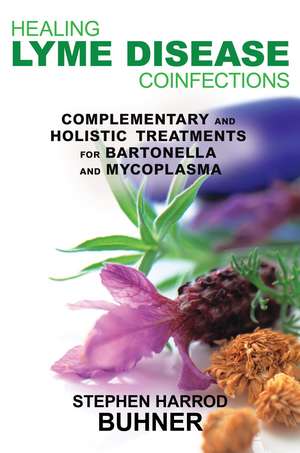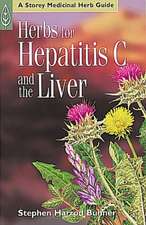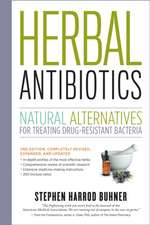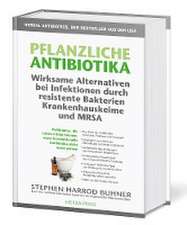Healing Lyme Disease Coinfections: Complementary and Holistic Treatments for Bartonella and Mycoplasma
Autor Stephen Harrod Buhneren Limba Engleză Paperback – 5 mai 2013
Preț: 92.65 lei
Preț vechi: 119.16 lei
-22% Nou
Puncte Express: 139
Preț estimativ în valută:
17.73€ • 19.25$ • 14.89£
17.73€ • 19.25$ • 14.89£
Carte disponibilă
Livrare economică 04-16 aprilie
Preluare comenzi: 021 569.72.76
Specificații
ISBN-13: 9781620550083
ISBN-10: 1620550083
Pagini: 512
Dimensiuni: 152 x 229 x 25 mm
Greutate: 0.68 kg
Ediția:Original.
Editura: Inner Traditions/Bear & Company
Colecția Healing Arts Press
ISBN-10: 1620550083
Pagini: 512
Dimensiuni: 152 x 229 x 25 mm
Greutate: 0.68 kg
Ediția:Original.
Editura: Inner Traditions/Bear & Company
Colecția Healing Arts Press
Notă biografică
Stephen Harrod Buhner (1952–2022) lectured throughout the United States on herbal medicine, the sacredness of plants, and the intelligence of nature. His other books include Healing Lyme, The Secret Teachings of Plants, and The Transformational Power of Fasting.
Extras
Chapter 5
Natural Healing of Mycoplasma
In Depth
The first and most important thing to understand about the mycoplasmas are that they are very old. The ancestral mycoplasmas split off from the streptococcus branch of bacteria some 600 million years ago. The phytoplasmas that infect plants began to specialize some 500 million years ago, diversifying considerably at the emergence of flowering plants 140 million years ago. The mycoplasmas that cause human disease, that in fact specialize in the infection of mammals, began to develop along with the emergence of mammals themselves some 220 million years ago. Primates emerged around 100 million years ago, apes 28 million years ago. The earliest human ancestors showed up about 8 million years ago, neanderthals 2 million years ago, and modern humans 200,000 years ago. In all that time, the mycoplasmas have been specializing in infecting host species very similar to us. And they have gotten very good at it.
In contrast, pharmaceutical antibiotics were discovered in 1928 and only commercially produced in 1942. The first mycoplasma was only isolated in a lab by humans in 1937. By the 1990s researchers learned enough about them to grow (some of) them in labs. Only in the few decades since have the organisms begun to be studied in any depth. We’ve got maybe eighty years of experience with the mycoplasmas, science-wise; they have millions of years of experience with life-forms very similar to us. So, the first and most important thing to understand about the mycoplasmas is that they are very old, very experienced, very adaptable. We are babies in comparison; and, if you have looked at just how adaptable the mycoplasmas are, not very smart babies at that.
In order to successfully treat organisms as complex and as highly intelligent as the mycoplasmas, it is important to first get rid of all sense you may have of superiority to “stupid” bacteria due to our “superior” intelligence. Second, it is crucial to understand what they do and why they do it--and to begin to intervene in that process in a sophisticated way, that is, for us to adapt our own behaviors to theirs. In other words, to be like Ginger Rogers in relation to Fred Astaire--doing everything he did but in high heels and backward. And, with respect for their capacities, to begin to intervene in what they do at the subtlest levels possible.
In this process, it is also crucially important to support our most intelligent ally--the human body. Health, irrespective of what medical science does, cannot be restored if the human body does not also participate. For, like the mycoplasmas, the human body has come out of a long history of complex development on this planet and it has its own long-developed mechanisms for dealing with infections. Thus, supporting immune function as well as organ health is important.
If you know the type of Mycoplasma infection involved (that is, the particular species) and if you have a comprehensive symptom list it is much easier to design a protocol for a mycoplasmal infection. However, it is possible to develop a general protocol that can be applied to all Mycoplasma species. One caveat: this is a general protocol. The best protocols will be designed for the individual person and the specific species of Mycoplasma, and will be adjusted as needed during treatment.
SEVEN THINGS TO KEEP IN MIND
There are seven things to keep in mind when designing a mycoplasma treatment protocol.
1. Replace the nutrients that are scavenged by the mycoplasmas. This must be done to avoid nutrient depletion in the body and the problems it can cause. NOTE: This will NOT “feed” the mycoplasmas. They are doing just fine feeding themselves--from your body’s own tissues. Supplementation keeps your body from experiencing nutrient depletion as they do so. Crucially: all research has found that replacing scavenged nutrients is essential to restore normal cellular and organism functioning. I repeat . . . all research has found . . . (that’s good, repeat it as often as you can).
2. Reduce the cytokine cascade that the bacteria initiate. This will go a long way toward relieving the symptoms that mycoplasma infection causes and, important because the mycoplasmas use the cytokine cascade to break down tissues to acquire nutrients, this will begin to starve them, reducing their numbers.
3. Support and protect the organs and systems that the mycoplasmas affect. This will relieve many mycoplasmal symptoms; it will also reduce the organism’s nutrient intake since they gain many nutrients by breaking down parts of various organs and systems. Some of the most important are: red blood cells; endothelial tissues; mucous membrane systems; the brain, spinal cord, and peripheral nerves; collagen, cartilage, and synovial tissues; spleen and lymph system; and immune system. Also, in essence, mycoplasmas are first and foremost bacteria that infect the ciliary structures of the body. The more you protect such structures, the better your protocol will work.
4. Use specific mycoplasmal antibacterials to kill the mycoplasma organisms or at least severely restrict their numbers. Herbs, supplements, and antibiotics are all useful and highly synergetic for this. NOTE: Unless, specifically noted otherwise, antibiotics can be used along with ALL the herbs and supplements in this book.
5. Enhance immune function. The stronger the immune system, the less severe the course of the disease.
6. Address specific symptoms not addressed otherwise. This will reduce the symptom picture and increase the quality of life.
7. The most elegant interventions will act in three or more of these categories. That is, if you find an herb that a) replaces nutrients, b) reduces cytokine cascade, c) protects specific organ systems, and d) enhances immune function or is antibacterial or addresses specific symptoms (or every one of those things)--that is what an elegant intervention looks like. It is a way of identifying the most specific herb or supplement for treating a mycoplasma infection. Two of the best herbal examples of this are cordyceps and houttuynia.
Natural Healing of Mycoplasma
In Depth
The first and most important thing to understand about the mycoplasmas are that they are very old. The ancestral mycoplasmas split off from the streptococcus branch of bacteria some 600 million years ago. The phytoplasmas that infect plants began to specialize some 500 million years ago, diversifying considerably at the emergence of flowering plants 140 million years ago. The mycoplasmas that cause human disease, that in fact specialize in the infection of mammals, began to develop along with the emergence of mammals themselves some 220 million years ago. Primates emerged around 100 million years ago, apes 28 million years ago. The earliest human ancestors showed up about 8 million years ago, neanderthals 2 million years ago, and modern humans 200,000 years ago. In all that time, the mycoplasmas have been specializing in infecting host species very similar to us. And they have gotten very good at it.
In contrast, pharmaceutical antibiotics were discovered in 1928 and only commercially produced in 1942. The first mycoplasma was only isolated in a lab by humans in 1937. By the 1990s researchers learned enough about them to grow (some of) them in labs. Only in the few decades since have the organisms begun to be studied in any depth. We’ve got maybe eighty years of experience with the mycoplasmas, science-wise; they have millions of years of experience with life-forms very similar to us. So, the first and most important thing to understand about the mycoplasmas is that they are very old, very experienced, very adaptable. We are babies in comparison; and, if you have looked at just how adaptable the mycoplasmas are, not very smart babies at that.
In order to successfully treat organisms as complex and as highly intelligent as the mycoplasmas, it is important to first get rid of all sense you may have of superiority to “stupid” bacteria due to our “superior” intelligence. Second, it is crucial to understand what they do and why they do it--and to begin to intervene in that process in a sophisticated way, that is, for us to adapt our own behaviors to theirs. In other words, to be like Ginger Rogers in relation to Fred Astaire--doing everything he did but in high heels and backward. And, with respect for their capacities, to begin to intervene in what they do at the subtlest levels possible.
In this process, it is also crucially important to support our most intelligent ally--the human body. Health, irrespective of what medical science does, cannot be restored if the human body does not also participate. For, like the mycoplasmas, the human body has come out of a long history of complex development on this planet and it has its own long-developed mechanisms for dealing with infections. Thus, supporting immune function as well as organ health is important.
If you know the type of Mycoplasma infection involved (that is, the particular species) and if you have a comprehensive symptom list it is much easier to design a protocol for a mycoplasmal infection. However, it is possible to develop a general protocol that can be applied to all Mycoplasma species. One caveat: this is a general protocol. The best protocols will be designed for the individual person and the specific species of Mycoplasma, and will be adjusted as needed during treatment.
SEVEN THINGS TO KEEP IN MIND
There are seven things to keep in mind when designing a mycoplasma treatment protocol.
1. Replace the nutrients that are scavenged by the mycoplasmas. This must be done to avoid nutrient depletion in the body and the problems it can cause. NOTE: This will NOT “feed” the mycoplasmas. They are doing just fine feeding themselves--from your body’s own tissues. Supplementation keeps your body from experiencing nutrient depletion as they do so. Crucially: all research has found that replacing scavenged nutrients is essential to restore normal cellular and organism functioning. I repeat . . . all research has found . . . (that’s good, repeat it as often as you can).
2. Reduce the cytokine cascade that the bacteria initiate. This will go a long way toward relieving the symptoms that mycoplasma infection causes and, important because the mycoplasmas use the cytokine cascade to break down tissues to acquire nutrients, this will begin to starve them, reducing their numbers.
3. Support and protect the organs and systems that the mycoplasmas affect. This will relieve many mycoplasmal symptoms; it will also reduce the organism’s nutrient intake since they gain many nutrients by breaking down parts of various organs and systems. Some of the most important are: red blood cells; endothelial tissues; mucous membrane systems; the brain, spinal cord, and peripheral nerves; collagen, cartilage, and synovial tissues; spleen and lymph system; and immune system. Also, in essence, mycoplasmas are first and foremost bacteria that infect the ciliary structures of the body. The more you protect such structures, the better your protocol will work.
4. Use specific mycoplasmal antibacterials to kill the mycoplasma organisms or at least severely restrict their numbers. Herbs, supplements, and antibiotics are all useful and highly synergetic for this. NOTE: Unless, specifically noted otherwise, antibiotics can be used along with ALL the herbs and supplements in this book.
5. Enhance immune function. The stronger the immune system, the less severe the course of the disease.
6. Address specific symptoms not addressed otherwise. This will reduce the symptom picture and increase the quality of life.
7. The most elegant interventions will act in three or more of these categories. That is, if you find an herb that a) replaces nutrients, b) reduces cytokine cascade, c) protects specific organ systems, and d) enhances immune function or is antibacterial or addresses specific symptoms (or every one of those things)--that is what an elegant intervention looks like. It is a way of identifying the most specific herb or supplement for treating a mycoplasma infection. Two of the best herbal examples of this are cordyceps and houttuynia.
Cuprins
How to Use This Book and Who It Is For
1 Emerging Diseases and Coinfections: The New Epidemics
2 Mycoplasma: An Overview
3 A Technical Look at Mycoplasma and Its Cytokine Cascade
4 The Mycoplasma Protocol: A Very Simple Overview
5 Natural Healing of Mycoplasma: In Depth
6 Bartonella: An Overview
7 A Technical Look at Bartonella and Its Cytokine Cascade
8 Natural Healing of Bartonella: The Core Protocol and an Extended Repertory
9 A Very Brief Look at Treating Simultaneous Mycoplasma and Bartonella Coinfections: Some Final Considerations for Clinicians
10 What the Future Holds
Appendix: Sources of Supply
Acronyms Used in This Book
Works Cited
Bibliography
Index
1 Emerging Diseases and Coinfections: The New Epidemics
2 Mycoplasma: An Overview
3 A Technical Look at Mycoplasma and Its Cytokine Cascade
4 The Mycoplasma Protocol: A Very Simple Overview
5 Natural Healing of Mycoplasma: In Depth
6 Bartonella: An Overview
7 A Technical Look at Bartonella and Its Cytokine Cascade
8 Natural Healing of Bartonella: The Core Protocol and an Extended Repertory
9 A Very Brief Look at Treating Simultaneous Mycoplasma and Bartonella Coinfections: Some Final Considerations for Clinicians
10 What the Future Holds
Appendix: Sources of Supply
Acronyms Used in This Book
Works Cited
Bibliography
Index
Recenzii
“Brilliant as ever, Buhner once again brings us cutting-edge research about one of the more invasive and misdiagnosed epidemics of our time. Healing Lyme Disease Coinfections is not only a resounding wakeup call for all healthcare professionals but also offers an elegant and potent paradigm of healing disease that is synergistic, broad, and deeply caring. Buhner has created a brilliant, hopeful resource for everyone affected with Lyme and/or its coinfections.”
“Bacteria outnumber us, outthink us, cooperate better than we do, and inhabit a far wider range of ecological niches. Without them we would be dead, yet many of them are lethal. For the past one hundred years we have waged war on them, and we are losing. Stephen Harrod Buhner is not afraid. He is paving a path into a future where we use simple tools to nourish cooperative health. If you or anyone you love has ever had an infection, you need this book. At times technical, at others dryly lyrical, it is sure to become a gleaming guidepost to many who have resigned themselves to a lifetime of distress and a trusted reference for health professionals wishing to assist those with resistant and chronic infections.”
“Packed with information never before presented, Healing Lyme Disease Coinfections is a not-to-be-missed treasure on the topic of Lyme disease. While exploring numerous new therapeutic interventions, Buhner’s pure intent and deep wisdom unfold before the reader, while his humorous style lightens the journey. This book is a masterpiece that provides its readers with life-changing information and is poised to become the reference book for the ages.”
“Well rooted in the scientific literature and benefitting from a deeply cultivated knowledge of herbalism, this exceptionally well-written book is an empowering resource for those suffering from Lyme disease coinfections and an essential reference for their clinicians.”
“Buhner takes pains to make his book user-friendly by including easy-to-read summary chapters aimed at the patient or nonmedical reader, and comprehensive data and scientific discussions for the practitioner...Holistic medical practitioners and those open to alternative treatments, however, will find much to appreciate in this well-researched effort.”
“Chapters discuss the complicated interactions between these three infections, how they can go undiagnosed, and how holistic methods centered on herbs and supplements can treat symptoms and bring an immune system back into balance. A ‘must’ for any health collection!”
“Informed, informative, and very highly recommended for community and academic library Health/Medicine reference book collections, Healing Lyme Disease Coinfections should be considered essential reading for the non-specialist general reader with concerns about lyme disease with respect to themselves or a family member.”
“This is a must have if you have clients or family (or yourself) who are suffering from Lyme disease.”
“Buhner explains how to treat specific symptoms and bring the immune system back into balance. He has created a substantive resource for health professionals, and it also includes sections that speak directly to the non-professional reader.”
“Bacteria outnumber us, outthink us, cooperate better than we do, and inhabit a far wider range of ecological niches. Without them we would be dead, yet many of them are lethal. For the past one hundred years we have waged war on them, and we are losing. Stephen Harrod Buhner is not afraid. He is paving a path into a future where we use simple tools to nourish cooperative health. If you or anyone you love has ever had an infection, you need this book. At times technical, at others dryly lyrical, it is sure to become a gleaming guidepost to many who have resigned themselves to a lifetime of distress and a trusted reference for health professionals wishing to assist those with resistant and chronic infections.”
“Packed with information never before presented, Healing Lyme Disease Coinfections is a not-to-be-missed treasure on the topic of Lyme disease. While exploring numerous new therapeutic interventions, Buhner’s pure intent and deep wisdom unfold before the reader, while his humorous style lightens the journey. This book is a masterpiece that provides its readers with life-changing information and is poised to become the reference book for the ages.”
“Well rooted in the scientific literature and benefitting from a deeply cultivated knowledge of herbalism, this exceptionally well-written book is an empowering resource for those suffering from Lyme disease coinfections and an essential reference for their clinicians.”
“Buhner takes pains to make his book user-friendly by including easy-to-read summary chapters aimed at the patient or nonmedical reader, and comprehensive data and scientific discussions for the practitioner...Holistic medical practitioners and those open to alternative treatments, however, will find much to appreciate in this well-researched effort.”
“Chapters discuss the complicated interactions between these three infections, how they can go undiagnosed, and how holistic methods centered on herbs and supplements can treat symptoms and bring an immune system back into balance. A ‘must’ for any health collection!”
“Informed, informative, and very highly recommended for community and academic library Health/Medicine reference book collections, Healing Lyme Disease Coinfections should be considered essential reading for the non-specialist general reader with concerns about lyme disease with respect to themselves or a family member.”
“This is a must have if you have clients or family (or yourself) who are suffering from Lyme disease.”
“Buhner explains how to treat specific symptoms and bring the immune system back into balance. He has created a substantive resource for health professionals, and it also includes sections that speak directly to the non-professional reader.”
Descriere
A guide to the natural treatment of two of the most common and damaging coinfections of Lyme disease--Bartonella and Mycoplasma.




















